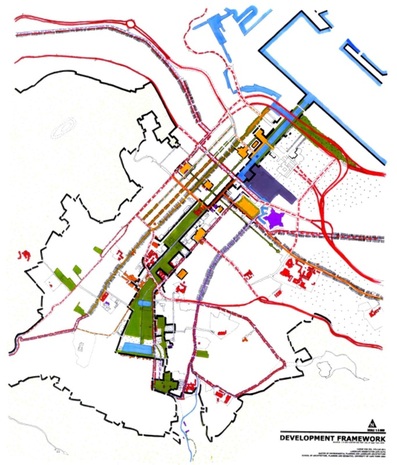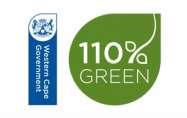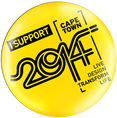WATER is the major theme of this proposal. The abundant flow of water from Table Mountain out into to Atlantic, with only a small amount being used for street washing and for occasional fire fighting of mountain fires, is ludicrously wasteful faced with the environmental and urban challenges of humankind in the 21st Century.
CAMISSA is an opportunity to provide an appropriate public landscape through the restitution of the city’s socio-ecological link between the mountain and the ocean.
The concept is to harness the current water that is wasted; transform the stormwater infrastructure and in so doing, create a powerful civic infrastructure that engages citizens in ways that conventional infrastructure is unable to do. This proposal is one that encompasses a vital sustainable water management strategy for the city and has the potential to reinstate the watercourses within the urban fabric, as a means to:
And so, to celebrate elements and remnants of the city’s history of civic hydrology, thereby raising awareness and enhancing the city with these place making elements and way finders of the cultural landscape - thereby providing the city with legibility, in the form of this connection.
In the renewal and maintenance of this system, employment would be provided, and the usage of the resource as a public asset will contribute to a sense of community.
The (re) implementation of this system - an ecological reclamation - not only provides the structure of the public realm of the city - but is indeed it's very reason and meaning.
CAMISSA is an opportunity to provide an appropriate public landscape through the restitution of the city’s socio-ecological link between the mountain and the ocean.
- It is essentially a vehicular free pedestrian spine, which acts as an integrating connector for a series of urban landscape interventions that re-unite the mountain and the ocean, with water being the key element.
- It provides a framework for public urban renewal and the expression of a collective cultural heritage, whilst providing an environmentally sustainable solution for the CBDs water to be collected, used to generate clean, cost effective energy which will renew the water to be used to revitalize and circulate through the public realm of the city, before irrigating the city’s green spaces and urban landscaping.
- Through public participation in civic hydrology, there will be a myriad of opportunities to recreation and public education, whilst providing the city with the legibility it deserves – taking meaning from the ancient Khoi name for Cape Town – Camissa – the place of sweet waters; the very raison d’etre.
- In the past this link structured and functioned in the city of Cape Town - it should not only re-structure the public realm of Cape Town, but also function and re-vitalise the city.
- Better use must be made of this scarce and renewable resource.
The concept is to harness the current water that is wasted; transform the stormwater infrastructure and in so doing, create a powerful civic infrastructure that engages citizens in ways that conventional infrastructure is unable to do. This proposal is one that encompasses a vital sustainable water management strategy for the city and has the potential to reinstate the watercourses within the urban fabric, as a means to:
- provide an ecosystem link from the mountain to the sea;
- meet performance criteria for sustainability and bio-diversity; link the natural, cultural and public urban environments whilst securing their value as educational and recreational resources;
- define neighbourhood boundaries;
- re-instate the sense of place that has been lost by vertical development, which has forced water underground into stormwater pipes;
- to provide energy required to renew and irrigate the water; and other possibilities for the local scale hydro-electric power supply for local lighting.
- enhance the physical environment, by sustainable and economical watering of green spaces and urban planting;
- and to maximise opportunities for water navigation, in order to reduce the carbon footprint.
And so, to celebrate elements and remnants of the city’s history of civic hydrology, thereby raising awareness and enhancing the city with these place making elements and way finders of the cultural landscape - thereby providing the city with legibility, in the form of this connection.
In the renewal and maintenance of this system, employment would be provided, and the usage of the resource as a public asset will contribute to a sense of community.
The (re) implementation of this system - an ecological reclamation - not only provides the structure of the public realm of the city - but is indeed it's very reason and meaning.
FRAMEWORK
CAMISSA is a development framework which, through the use of water, focuses on the reinstatement of the ecological link that reunites the mountain and the ocean into a public landscape, as a sustainable solution for Cape Town's CBD.
Ultimately, this framework would create a 'pedestrian spine' which acts as an integrating connector for a series of urban and landscape interventions that re-introduce the ecological system and its bio-diversity in the city. Water, being the key element in providing the city with access to the sea and bringing water back into the city. This provides a framework for public urban renewal and the expression of our collective cultural heritage, whilst providing an environmentally sustainable solution for the Table Valley Catchment Area's water to be collected, renewed, recycled, to generate energy, and used to revitalise the city space by circulating and falling abundantly throughout the CBD's public spaces. Through public participation in 'civic hydrology' - there will be a myriad of opportunities for recreation and education within this environmental connector, whilst providing the city with the legibility it deserves; taking meaning from the ancient name for Cape Town: CAMISSA - Khoi for 'the place of sweet waters' - the very raison d'etre for the establishment of settlement at the tip of Africa.
Ultimately, this framework would create a 'pedestrian spine' which acts as an integrating connector for a series of urban and landscape interventions that re-introduce the ecological system and its bio-diversity in the city. Water, being the key element in providing the city with access to the sea and bringing water back into the city. This provides a framework for public urban renewal and the expression of our collective cultural heritage, whilst providing an environmentally sustainable solution for the Table Valley Catchment Area's water to be collected, renewed, recycled, to generate energy, and used to revitalise the city space by circulating and falling abundantly throughout the CBD's public spaces. Through public participation in 'civic hydrology' - there will be a myriad of opportunities for recreation and education within this environmental connector, whilst providing the city with the legibility it deserves; taking meaning from the ancient name for Cape Town: CAMISSA - Khoi for 'the place of sweet waters' - the very raison d'etre for the establishment of settlement at the tip of Africa.
|
Map by Caron von Zeil.
|
The COMPOSITE PLAN consists of a separate series of systems maps - which form part of the Development Framework, namely:
• BLUE HYDROLOGY / CIVIC HYDROLOGY • GREEN GREEN & URBAN OPEN SPACE SYSTEMS & STREET TREES • PURPLE HISTORIC / HERITAGE / CULTURAL LANDSCAPE • RED URBAN INFRASTRUCTURE / TRANSPORT/ URBAN MOBILITY • ORANGE PUBLIC AMENITIES • YELLOW HOUSING • PINK ECONOMIC GENERATORS |
SYNTHESIS OF INFORMANTS
UNDER CONSTRUCTION
LANDSCAPE DEVELOPMENT FRAMEWORK
UNDER CONSTRUCTION
FRAMEWORK STRUCTURE
UNDER CONSTRUCTION
SYSTEMATIC LAYERS
UNDER CONSTRUCTION
© COPYRIGHT
ALL RIGHTS ARE RESERVED by THE RECLAIM CAMISSA TRUST No. IT 2882/2010.
The use of material on this page is permitted with acknowledgement of the source and prior written consent - contactable via [email protected]
ALL RIGHTS ARE RESERVED by THE RECLAIM CAMISSA TRUST No. IT 2882/2010.
The use of material on this page is permitted with acknowledgement of the source and prior written consent - contactable via [email protected]




